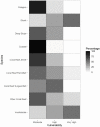Assessing the vulnerability of marine life to climate change in the Pacific Islands region
- PMID: 35802686
- PMCID: PMC9269963
- DOI: 10.1371/journal.pone.0270930
Assessing the vulnerability of marine life to climate change in the Pacific Islands region
Abstract
Our changing climate poses growing challenges for effective management of marine life, ocean ecosystems, and human communities. Which species are most vulnerable to climate change, and where should management focus efforts to reduce these risks? To address these questions, the National Oceanic and Atmospheric Administration (NOAA) Fisheries Climate Science Strategy called for vulnerability assessments in each of NOAA's ocean regions. The Pacific Islands Vulnerability Assessment (PIVA) project assessed the susceptibility of 83 marine species to the impacts of climate change projected to 2055. In a standard Rapid Vulnerability Assessment framework, this project applied expert knowledge, literature review, and climate projection models to synthesize the best available science towards answering these questions. Here we: (1) provide a relative climate vulnerability ranking across species; (2) identify key attributes and factors that drive vulnerability; and (3) identify critical data gaps in understanding climate change impacts to marine life. The invertebrate group was ranked most vulnerable and pelagic and coastal groups not associated with coral reefs were ranked least vulnerable. Sea surface temperature, ocean acidification, and oxygen concentration were the main exposure drivers of vulnerability. Early Life History Survival and Settlement Requirements was the most data deficient of the sensitivity attributes considered in the assessment. The sensitivity of many coral reef fishes ranged between Low and Moderate, which is likely underestimated given that reef species depend on a biogenic habitat that is extremely threatened by climate change. The standard assessment methodology originally developed in the Northeast US, did not capture the additional complexity of the Pacific region, such as the diversity, varied horizontal and vertical distributions, extent of coral reef habitats, the degree of dependence on vulnerable habitat, and wide range of taxa, including data-poor species. Within these limitations, this project identified research needs to sustain marine life in a changing climate.
Conflict of interest statement
The authors have declared that no competing interests exist.
Figures


















References
-
- Intergovernmental Panel on Climate Change. Global Warming of 1.5°C: An IPCC Special Report on the Impacts of Global Warming of 1.5°C Above Pre-industrial Levels and Related Global Greenhouse Gas Emission Pathways, in the Context of Strengthening the Global Response to the Threat of Climate Change, Sustainable Development, and Efforts to Eradicate Poverty. Intergovernmental Panel on Climate Change; 2018.
MeSH terms
LinkOut - more resources
Full Text Sources
Medical

